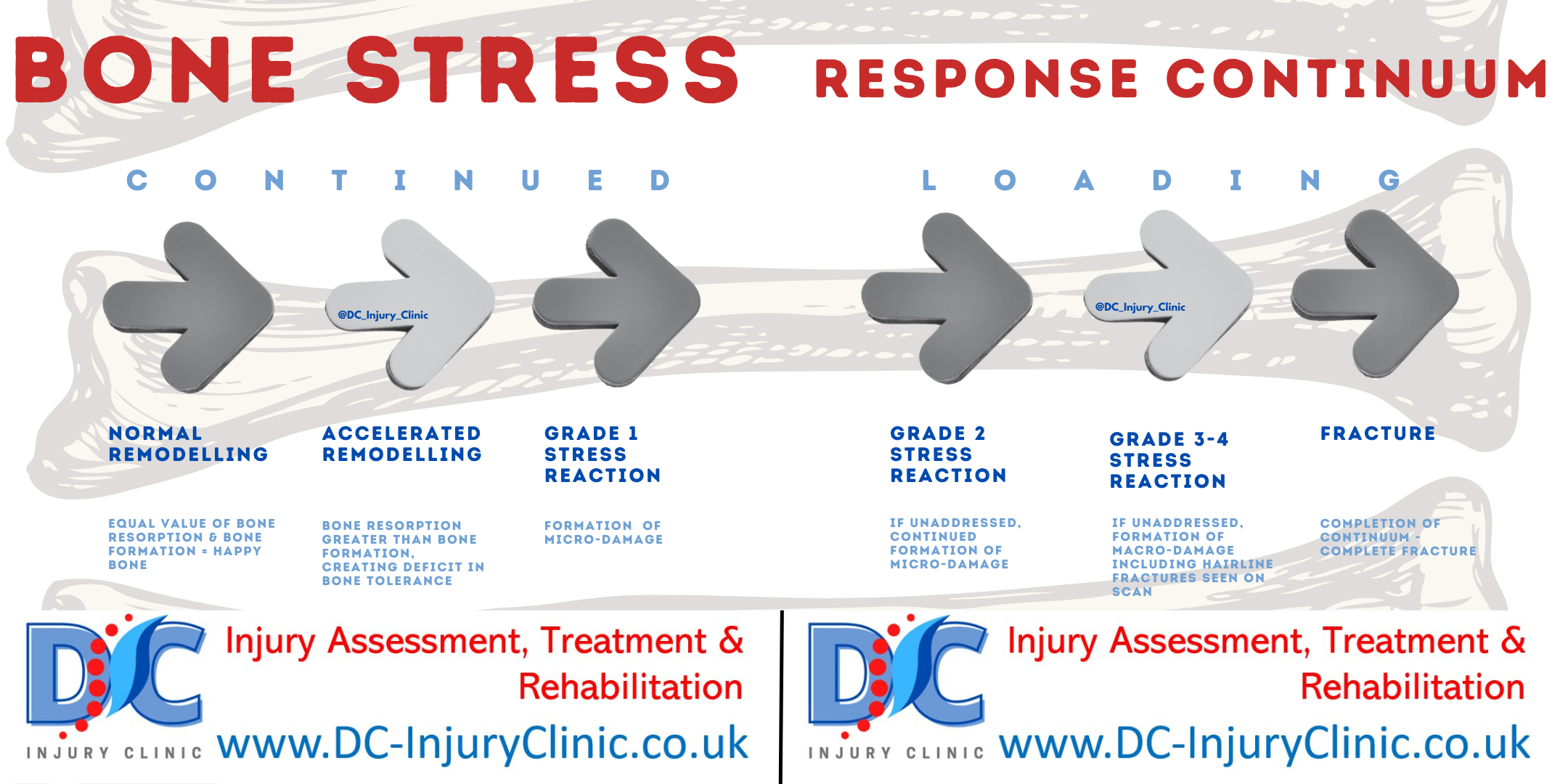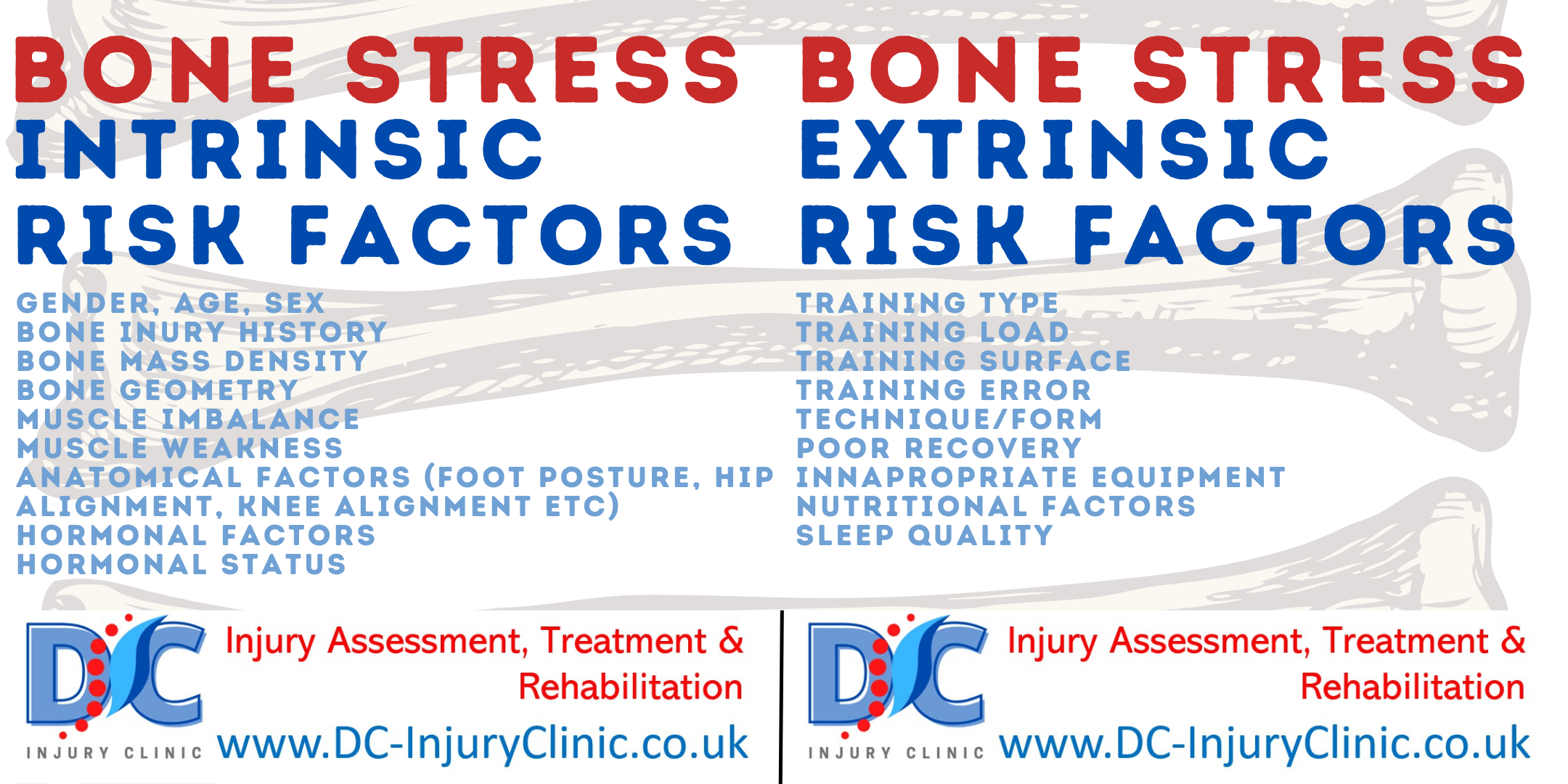I made the decision to start my blog with a condition that has been fundamental in my progression from perma-injured semi-professional footballer, to running DC Injury Clinic. Anyone who has had the misfortune of being a team mate of mine over the years – generally involving chasing my ‘Hollywood’ 40 yard passes out of play – will know of my on-going battle against, and whining about, shin pain, so I can now look at what is generally called “Shin Splints” from both sides of the treatment table. I say generally called as Shin Splints is very much an umbrella term for lower leg pain, and so the location of the pain, the cause of the pain and therefore the treatment of the condition can all vary massively. In this blog, I am going to take a brief look at a handful of conditions:
Stress Fractures & Medial Tibial Stress Syndrome: Bone stress injuries are not common despite their fearsome reputation. They can range from a simple stress “reaction” – Medial Tibial Stress Syndrome (painful bone with absence of crack) – to the more advanced stress fracture (painful bone with a hairline crack).
There are subtle, but specific differences between the two;
– Medial tibial stress syndrome (MTSS) is the most common diagnosis of “shin splints”, and ordinarily presents as diffuse pain along the bottom two thirds of the shin bone, along the inner aspect. Often the pain will be worse first thing in the morning, decrease after warming up, but will gradually return after exercise.
– Stress fractures typically reveal themselves insidiously, starting as a mild ache with localized tenderness, and developing into worsening, sharp and very pinpoint pain. Constant pain which worsens with exercise/activity is indicative of a stress fracture, and night pain is a call to get checked out.
The diagnosis and differentiation of a bone stress injury can usually be made in clinical examination by an experienced therapist, using specific tests and thorough history taking. Imaging is not always necessary and many bone
stress injuries are not visible on x-ray, particularly during the early stages of the injury, with many false-negatives.
IF YOU SUSPECT A BONY INJURY, I STRONGLY ADVISE THAT YOU GET SOMEONE QUALIFIED TO CHECK THIS OUT.
Periostitis: Bones are encased in a blood and nutrient rich membrane called a Periosteum, and ‘..itis’ is inflammation, so basically the clingfilm like wrap around the bone is becoming inflamed and thus putting pressure on the bone. This is mainly considered an over use injury, and generally the pain occurs at the inside lower half of the shin. In many cases it is very painful at the start of exercise, but pain eases as exercise continues, only to return afterwards. Lumps or bumps may be felt when feeling along the inside of the shin bone. This is the type I was ‘diagnosed’ with, becoming so problematic that I had an operation on both legs to drain the excess blood within the membrane, which proved unsuccessful. I then went through numerous steroid injections (cortisone) afterwards – again, unsuccessfully.
Compartment Syndrome: This is essentially where the separate compartments of the lower leg (below the knee) grow to such an extent that layers of soft tissue that encase it (fascia, skin) cannot grow at the same rate and so the nerve endings, blood vessels and even bone that is underneath starts being crushed. This can result in depleted blood flow and oxygen to fuel the muscle, and this could eventually lead to the muscle dying. Compartment syndrome can start fairly suddenly, and key signs include pain even when at rest, a tightness of the area, numbness, paleness and the area may feel cold and hard to touch.
Muscle Problems: I think we all have a tendency to ‘fear the worst’, certainly if we are deep in a training regime for a marathon; the up coming season; an imminent event. But often these pains are merely the soft tissues (Muscle, Tendon, Ligament) being over-loaded. Everyone who spends any amount of time on their feet will at some stage feel aches and pains between the knee and the ankle. Consider a typical runner will be putting those joints under 2-4 times their own body weight (depending on your source) PER STEP, and you can imagine the stress that our soft tissue are put under. These are often completely normal, and harmless – but when in doubt, get it checked out.
Risk Factors & Self Treatment: There are intrinsic and extrinsic risk factors to consider, which can be seen in full on the image below, and include training type/load/surface, recovery protocol, but also age/gender/sex.
And as you can appreciate, there is no one answer to the treatment as everyone’s “shin splints” could be very different.
One common factor in the cause, however, is load application – or how much force is going through the lower leg. A simple solution would be to say ‘stop the high impact training’, but as I was never happy with that advice myself, I loathe to give it to you. But load management is fundamental in the recovery from shin pain, and this should be the primary line of questioning. This is not the same as complete rest, and training should be able to continue at some level, in some format, usually alongside a sensibly graded rehab program.
N.B. There are no ‘one size fits all’ style quick fixes in most injury scenarios, so these article shouldnt be seen as such. They are merely guides to a better understanding of how our bodies work.
For more information please contact Dan@DC-InjuryClinic.co.uk

